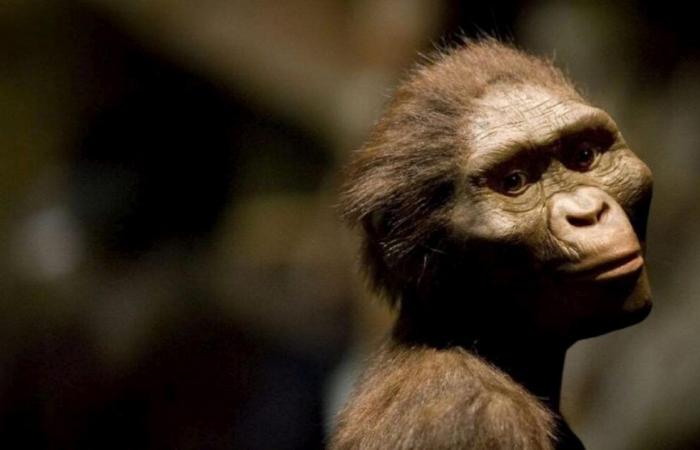Yves Coppens discovered Lucy, invented the “East side story”, called modern paleontology the “bone rush”. He had revealed to us our origins: the great African fault, the Rift. With the australopithecines, or pre-men, to the east, and the great apes to the west, our vague cousins.
Evolution, a beautiful story
“I wouldn't say Abel was talking, but I wouldn't say the opposite either. »
Because he is a fantastic communicator and popularizer, Yves Coppens told us this beautiful story of evolution: a lush West of tropical forests where living was like swinging from branch to branch, a desert East of wooded savannah where to live it was to stand on two legs, to run, to hunt or to be hunted. On either side of the Rift, it was necessary to adapt to the environment. A story so inspired by Darwin's theories and so attractive that it had, over the years, enjoyed a growing consensus within the community of paleoanthropologists. Thus, the sites of Afar and Omo, in Ethiopia, important deposits of hominid bones, have long been considered the true cradle of humanity. A sinister wink from History which makes this Ethiopian land where man cut his teeth the poorest in the world.
“But I only proposed a model, a possible scenario. If this model falls, we will make another,” the famous professor at the Collège de France gently apologizes today. The discovery of Abel, 2,500 kilometers west of the Great Rift, in a Chadian desert, is cracking the model. Within a few hundred thousand years, Abel is contemporary with Lucy. It would be approximately 3.5 million years old.
Until then, Abel is just a lower jaw. With seven teeth. But, for paleontologists, this is more than sufficient to determine the degree of evolution of this pre-man, previously classified as Australopithecus Afarensis like Lucy, but which could soon have a classification of its own. Because Abel is clearly different from his Ethiopian cousin: his premolars have three roots, his mandibular symphysis is very advanced. To the point that Yves Coppens almost sees the beginnings of a speaking being… “I wouldn't say that Abel spoke, but I wouldn't say the opposite either. »
A village on the shores of Lake Turkana, on the borders of Ethiopia and Kenya, Lucy's country.
DR
On the edge of the sand
Lulled by Coppens' theories, Michel Brunet and his friends were looking for remains of great apes there. They found a pre-man.
Yves Coppens knows how to carefully balance the prudence of hypotheses and bold declarations. His adventure in Ethiopia taught him that we do more good for paleoanthropology by talking about it than by remaining silent. And by simply speaking. The story of the Australopithecus Afarensis named Lucy because researchers were listening to the Beatles song “Lucy in the sky with diamonds” has gone around the world. Just before “Indiana Jones”, “Jurassic Park” and other American fictions come to confirm this dusted image of the archaeo-anthropo-paleontologist. Seen through the prism of Coppens, the story of the origins of man is a modern, exciting and very popular adventure.
But Coppens is no longer the hero of this adventure. He has just had the spotlight stolen by one of his friends, Michel Brunet, professor of paleontology at the Poitiers science faculty. For this mandible picked from the edge of the sand in the Chadian desert, one early morning in January 1995.
Lulled by Coppens' theories, Michel Brunet and his friends were looking there for remains of great apes. They found a pre-man. “In the east, we found nearly 3,000 human bones. To the west, nothing. It could reasonably be estimated that the origins of man were in the east. Abel comes to disturb our assumptions. But without completely calling them into question,” argues Yves Coppens all the same.
Videos. The Lascaux cave in Dordogne, such a fragile world heritage
Well preserved for 21,000 years, the cave and its superb paintings have suffered since they were brought to light in 1940. On January 9, 2008, the cave underwent a three-day intensive care treatment to limit the progression of the black spots. A look back at the tumultuous history of the conservation of a legendary site
Find the Mutant
What are they all looking for in Africa? The missing link, of course, which is to paleontology what the zero degree of infinity is to mathematics or the G-spot to eroticism.
Michel Brunet smiles in his beard. He is convinced that in the Koro Koto desert, where he discovered Abel, he can go back much further than 3.5 million years: “We have to do drilling. And to drill, you need money. Our estimated budget for the next five years is only 5 million francs. With 2 million francs from the first year. Success in paleontology is also a matter of big money. » Which did not prevent him from making his famous discovery with only a few companions and two jeeps while drifting east due to a sandstorm. Not very scientific, but science is also built on chance. The fact remains: to continue his research, he can no longer rely on luck but on the method and the means to implement this method. We must go back in time by penetrating the geological layers of the desert which gave birth to Abel's jaw. Analyze all the animal fossils found there. “There are ten or fifteen years of work in this sector,” smiles Michel Brunet.
What are they all looking for in Africa? The missing link, of course, which is to paleontology what the zero degree of infinity is to mathematics or the G-spot to eroticism. “The closer you get to it, the farther away it gets. Especially since we have not succeeded in determining its exact dating and we do not really know if there is one or more,” admits Yves Coppens, fatalistic. There was a mutant, at some point in the history of the globe, who had some ape characteristics and some hominid characteristics. It is this pivotal animal-being that fascinates scientists of the past.
Those who are feverishly awaiting the crossroads bone of the ape and man risk waiting a long time to come. Based on the evidence that it is more important to seek than to find, French and American paleontologists continue to turn over the African soil with faith. The cradle of humanity is there. They are firmly convinced of this. Not necessarily to the east of the great tectonic fault, as we believed just a year ago, but not necessarily to the west either. Somewhere, beneath the hot earth of the Dark Continent, lies another tibia, another skull or a jaw that tells a little more than Lucy or Abel about our origins. But that doesn't say everything.
The big dates
February 7, 1925: A fossil skull discovered a few months earlier in Taung Cave, South Africa, is described by Professor Raymond Dart as the first Australopithecus africanus (3 million years old). July 17, 1959: Marie Leakey, wife of the famous paleontologist Louis Leakey, discovered the skull of Zinjanthropus bosei in the Olduvaï gorge, in Tanzania. 1961 : Marie Leakey, again, discovered in the Olduvaï cave the skull of a homo habilis – 1.8 million years old -, the first man, prosaically baptized “ER1470”. The volume of the brain exceeds that of australopithecines by 45%. 1974 : Yves Coppens, Donald Jonhanson and Maurice Taïeb uncover fifty-two bone fragments of a 3.5 million year old Australopithecus Afaranis (Lucy), in Afar, southern Ethiopia. 1995 : Michel Brunet discovers the lower jaw of an australopithecus contemporary with Lucy 2,500 kilometers west of the Rift.







